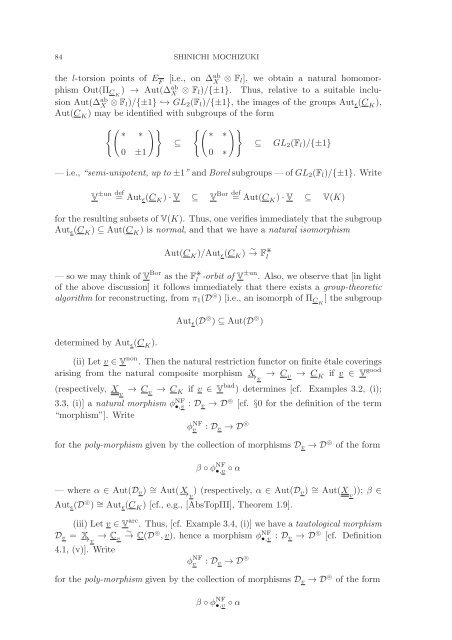Inter-universal Teichmuller Theory I: Construction of Hodge Theaters
Inter-universal Teichmuller Theory I: Construction of Hodge Theaters
Inter-universal Teichmuller Theory I: Construction of Hodge Theaters
You also want an ePaper? Increase the reach of your titles
YUMPU automatically turns print PDFs into web optimized ePapers that Google loves.
84 SHINICHI MOCHIZUKI<br />
the l-torsion points <strong>of</strong> E F<br />
[i.e., on Δ ab<br />
X ⊗ F l], we obtain a natural homomorphism<br />
Out(Π CK ) → Aut(Δ ab<br />
X ⊗ F l)/{±1}. Thus, relative to a suitable inclusion<br />
Aut(Δ ab<br />
X ⊗ F l)/{±1} ↩→ GL 2 (F l )/{±1}, the images <strong>of</strong> the groups Aut ɛ (C K ),<br />
Aut(C K ) may be identified with subgroups <strong>of</strong> the form<br />
{( )} {( )}<br />
∗ ∗<br />
∗ ∗<br />
⊆<br />
⊆ GL 2 (F l )/{±1}<br />
0 ±1<br />
0 ∗<br />
— i.e., “semi-unipotent, up to ±1” and Borel subgroups — <strong>of</strong> GL 2 (F l )/{±1}. Write<br />
V ±un def<br />
=Aut ɛ (C K ) · V ⊆ V Bor def<br />
=Aut(C K ) · V ⊆ V(K)<br />
for the resulting subsets <strong>of</strong> V(K). Thus, one verifies immediately that the subgroup<br />
Aut ɛ (C K ) ⊆ Aut(C K )isnormal, and that we have a natural isomorphism<br />
Aut(C K )/Aut ɛ (C K ) ∼ → F l<br />
—sowemaythink<strong>of</strong>V Bor as the F l -orbit <strong>of</strong> V±un . Also, we observe that [in light<br />
<strong>of</strong> the above discussion] it follows immediately that there exists a group-theoretic<br />
algorithm for reconstructing, from π 1 (D ⊚ ) [i.e., an isomorph <strong>of</strong> Π CK ] the subgroup<br />
determined by Aut ɛ (C K ).<br />
Aut ɛ (D ⊚ ) ⊆ Aut(D ⊚ )<br />
(ii) Let v ∈ V non . Then the natural restriction functor on finite étale coverings<br />
arising from the natural composite morphism X −→v → C v → C K if v ∈ V good<br />
(respectively, X v<br />
→ C v → C K if v ∈ V bad ) determines [cf. Examples 3.2, (i);<br />
3.3, (i)] a natural morphism φ•,v NF : D v →D ⊚ [cf. §0 for the definition <strong>of</strong> the term<br />
“morphism”]. Write<br />
: D v →D ⊚<br />
φ NF<br />
v<br />
for the poly-morphism given by the collection <strong>of</strong> morphisms D v →D ⊚ <strong>of</strong> the form<br />
β ◦ φ NF<br />
•,v ◦ α<br />
—whereα ∈ Aut(D v ) ∼ = Aut(X −→v ) (respectively, α ∈ Aut(D v ) ∼ = Aut(X v<br />
)); β ∈<br />
Aut ɛ (D ⊚ ) ∼ = Aut ɛ (C K ) [cf., e.g., [AbsTopIII], Theorem 1.9].<br />
(iii) Let v ∈ V arc . Thus, [cf. Example 3.4, (i)] we have a tautological morphism<br />
∼<br />
D v = −→v X → C v → C(D ⊚ ,v), hence a morphism φ NF<br />
•,v : D v →D ⊚ [cf. Definition<br />
4.1, (v)]. Write<br />
: D v →D ⊚<br />
φ NF<br />
v<br />
for the poly-morphism given by the collection <strong>of</strong> morphisms D v →D ⊚ <strong>of</strong> the form<br />
β ◦ φ NF<br />
•,v ◦ α
















